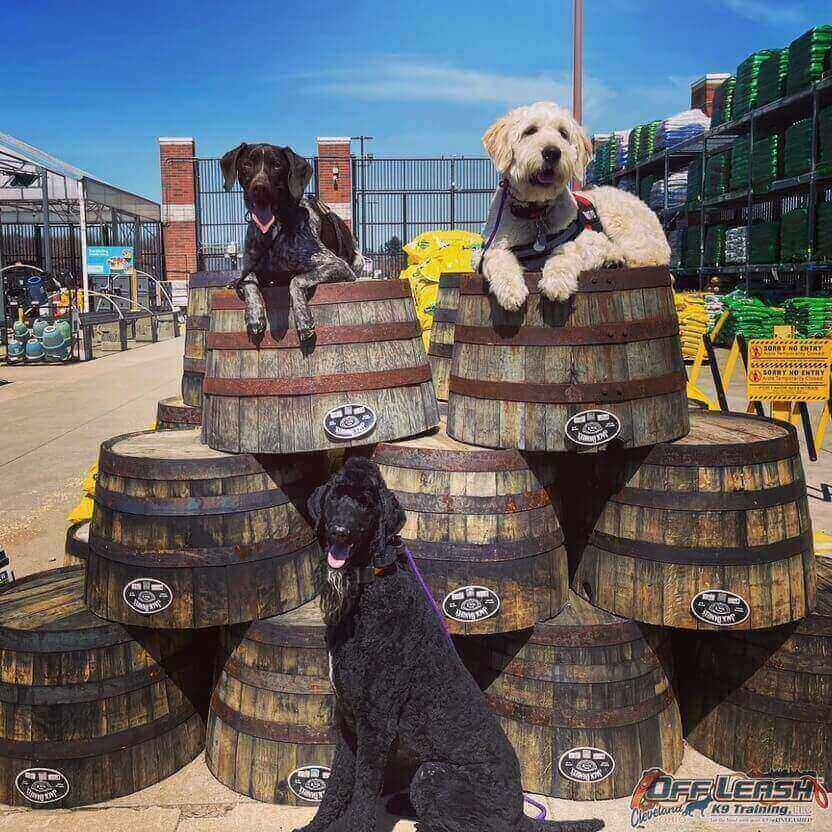What is the Best Age to Start Training a Dog? Unlock your Pup’s Potential
One of the most common questions new pet owners face is, “What is the best age to start training a dog?” Understanding the optimal time to begin training can significantly impact your dog’s development, behavior, and overall well-being.
In this guide, we’ll explore the ideal age to start training your pup, the benefits of early training, and practical tips to unlock your dog’s full potential. Whether you have a playful puppy or an older dog, it’s never too late to begin the journey of training and creating a harmonious relationship with your canine companion.
At What Age Should I Begin Training My Puppy?
The best time to start training a puppy is as soon as you bring them home, which is typically around 8 weeks of age. At this young age, puppies are highly receptive to learning and can begin to grasp basic commands and socialization skills.
This window is ideal for the following reasons:
- High Receptiveness: Puppies at this age have a natural curiosity and willingness to please, making them receptive to learning basic commands and good manners.
- Brain Development: Their brains are actively developing, making it easier for them to form positive associations with training and desired behaviors.
- Socialization Window: This period is also prime time for socialization, which involves exposing your puppy to new people, animals, and environments. Early socialization helps prevent fear and anxiety later in life.
While formal training classes might not be suitable until your pup is a bit older, you can definitely start with basic commands like “sit,” “stay,” and “come” during this period. Remember, training should be a positive experience with plenty of praise and rewards.
Benefits of Training a Puppy
Aside from the strong bond you forge with your puppy during training, there are tons of benefits you can get from training your puppy early on.
- Safety: A trained puppy is less likely to engage in dangerous behaviors. Commands like “stay,” “come,” and “leave it” can prevent your dog from running into traffic, ingesting harmful substances, or getting into fights with other animals.
- Socialization: Training involves exposing your puppy to various people, animals, and environments. This socialization process helps them become well-adjusted and confident, reducing the likelihood of fear or aggression in new situations.
- Mental Exercise: Training provides mental challenges that keep your puppy’s mind sharp and engaged. This mental stimulation can prevent boredom, which often leads to destructive behaviors.
- Reduced Behavioral Problems: Puppies are naturally curious and energetic, and without proper training, their curiosity can often lead to destructive behaviors like chewing, digging, or jumping. Training provides a healthy outlet for your pup’s energy and teaches them what behaviors are and aren’t acceptable. This can significantly reduce the likelihood of behavioral problems developing later in life.
- More Enjoyable Outings: A well-trained dog is a joy to take out and about. Whether you’re going for a walk in the park, visiting friends, or running errands, a dog who listens to your commands will make the experience more enjoyable for everyone involved. You’ll be able to relax and have fun with your furry companion, knowing they’ll behave appropriately in different situations.
What are the Essential Training Sessions for a New Puppy?
In this section, we’ll explore the key training sessions every new puppy should undergo. These foundational training exercises are crucial for shaping your puppy’s behavior, ensuring their safety, and fostering a strong bond between you and your new companion. These house training, basic commands, socialization, leash training, and crate training. By focusing on these essential areas, you can set your puppy up for a happy, well-behaved, and well-adjusted life.
Potty Training
Here are the steps to potty train your pup:
- Establish a schedule: Create a consistent potty schedule, taking your puppy outside every 2 hours initially, and gradually increasing the interval as they develop better bladder control.
- Location, location, location: Choose a specific elimination spot outdoors and always take your puppy to that same location. This helps them understand where they’re expected to go.
- Praise and reward: When your puppy eliminates outdoors, lavish them with praise and offer a small treat. This positive reinforcement helps them associate going potty in the right place with good things.
Accidents happen, especially during the learning process. Clean up accidents with an enzymatic cleaner to remove any lingering odors that might attract your puppy back to that spot.
Crate Training
Crate training is a fantastic way to give your new puppy a safe and secure space to relax, and it can also be a valuable tool in potty training. Here’s a guide to get you started on crate training your furry friend:
- Pick the perfect crate – Select a crate that’s just the right size for your pup. They should be able to stand up, turn around comfortably, and lie down without feeling cramped.
- Make it cozy – Line the crate with comfy bedding and add a favorite toy or treat inside. This will help your puppy associate the crate with positive experiences.
- Start slow – Don’t force your puppy into the crate. Leave the door open and toss treats or kibble inside to encourage them to explore on their own terms. Praise them whenever they enter the crate willingly.
- Short crate time – For young puppies, start with short crate sessions. A good rule of thumb is no more than one hour per month of age (up to a maximum of 3-4 hours). Gradually increase the duration as your puppy becomes comfortable.
- Feed in the crate – Try feeding your puppy their meals inside the crate. This creates a positive association with the crate as a place where good things happen.
Basic Obedience Training Techniques
Here are some tips on how to teach your puppy basic obedience training techniques:
- Find a quiet, distraction-free location for training sessions. This will help your puppy focus on you and learn more effectively.
- Keep training sessions short and engaging, especially for young puppies. Aim for 5-10 minute sessions several times a day.
- Reward your puppy with praise, treats, or toys for following your commands. This makes training fun and motivates them to learn.
- Always use the same word or phrase for each command (e.g., “sit” instead of “down” or “stay”). Consistency helps your puppy understand what you expect.
- Begin with basic commands like “sit,” “stay,” “come,” “down,” and “leave it.” Gradually introduce more complex commands as your puppy masters the basics.
- Be patient and have fun! Puppy training takes time and patience. Celebrate small successes and make training sessions enjoyable for both you and your furry friend.
How to Socialize your Puppy
Socializing a young puppy is a critical part of their development, helping them grow into well-adjusted, confident, and friendly dogs. Early socialization involves exposing your puppy to a variety of people, animals, environments, and experiences in a positive and controlled manner. This process reduces the likelihood of fear-based behaviors and aggression later in life.
In this section, we’ll discuss effective strategies and tips for socializing your young puppy, ensuring they adapt well to different situations and thrive in diverse settings.
The Importance of Early Puppy Socialization
Early puppy socialization is absolutely crucial for raising a well-adjusted and confident dog. It’s like a magic window during a puppy’s development where they are most receptive to learning about the world around them.
Building Confidence and Reducing Fear
By introducing your puppy to new sights, sounds, smells, people, and animals in a positive way during this socialization period, you help them develop confidence and overcome potential fears. They learn that these new things are not scary but part of the normal world.
Unsocialized puppies can become anxious or fearful of anything unfamiliar later in life. This can lead to behavioral problems like barking, lunging, or hiding in new situations. Early socialization helps prevent these anxieties from developing.
Creating a Well-Behaved Companion
Socialization teaches puppies proper dog etiquette when interacting with other dogs. They learn how to play appropriately and avoid conflict.
A well-socialized dog is adaptable and comfortable in different environments. They can handle going to the vet, the park, or meeting new people with ease. This makes life much more enjoyable for both you and your furry friend.
Leash Training for Young Puppies
Leash training can feel like a challenge with a young, energetic puppy, but with patience and positive reinforcement, you can lay the foundation for enjoyable walks together. Here’s a guide to leash training your young pup:
- Get your puppy comfortable with the collar or harness and leash before venturing outside. Let them wear it around the house while playing or offering treats to create positive associations.
- The key to leash training is rewarding desired behavior. When your puppy walks nicely by your side on a loose leash, offer praise, treats, or a favorite toy. This reinforces good leash manners.
- If your puppy starts pulling on the leash, stop walking. Stand still and wait for them to return to your side with a loose leash. Once they’re calm, reward them and continue walking. This teaches them pulling gets them nowhere.
- If your puppy lunges or pulls towards something interesting, gently change direction and head back the other way. This redirects their attention and discourages pulling towards distractions.
By following these tips and using positive reinforcement techniques, you can successfully leash train your young puppy and ensure your walks together are enjoyable adventures for both of you.
How to Ensure Successful Training with Your Puppy?
Ensuring successful training with your puppy involves a combination of consistency, patience, and positive reinforcement.
Start by establishing a regular training routine, dedicating specific times each day for training sessions. Keep these sessions short and fun to maintain your puppy’s interest and avoid overwhelming them.
Consistency is key; use the same commands and rewards each time to help your puppy understand what is expected. Positive reinforcement, such as treats, praise, and play, is essential for encouraging good behavior and making training a positive experience for your puppy.
Socialization is also a crucial aspect of successful training. Expose your puppy to a variety of people, animals, and environments to build their confidence and adaptability.
This helps prevent fear-based behaviors and aggression in the future. Additionally, crate training can be a valuable tool, providing your puppy with a safe space and aiding in house training.
Remember to be flexible and adjust your training methods based on your puppy’s progress and personality. Every puppy is different, and what works for one may not work for another.
By maintaining a positive, patient, and consistent approach, you can ensure successful training and foster a strong, trusting bond with your puppy.
Ready to raise a happy, well-behaved pup, but feeling overwhelmed by the training process? You’re not alone! Professional puppy training can be a game-changer for both you and your furry friend.
Considering professional puppy training? We can help! Contact us today to discuss your needs and explore how professional training can benefit you and your furry companion. Together, let’s create a happy and well-adjusted dog for life!

